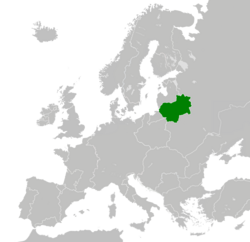Kingdom of Lithuania | |||||||||
|---|---|---|---|---|---|---|---|---|---|
| 1251–1263 | |||||||||
 Kingdom of Lithuania at its peak | |||||||||
| Capital | Kernavė | ||||||||
| Common languages | Lithuanian, Ruthenian | ||||||||
| Religion |
| ||||||||
| Government | Hereditary feudal absolute monarchy | ||||||||
| King | |||||||||
• 1251–1263 | Mindaugas | ||||||||
| History | |||||||||
• Established | 17 July 1251 | ||||||||
• Coronation of Mindaugas | 6 July 1253 | ||||||||
• Mindaugas assassinated | 12 September 1263 | ||||||||
| Currency | Ilgasis | ||||||||
| |||||||||
The Kingdom of Lithuania was a sovereign state that existed from the 17 July 1251 until the death of the first crowned king of Lithuania, Mindaugas, on 12 September 1263.[1] Mindaugas was the only Lithuanian monarch crowned king with the assent of the Pope and the head of the first catholic Lithuanian state. The formation of the kingdom is widely regarded as a partially successful attempt at unifying all surrounding Baltic tribes, including the Old Prussians, into a single unified state under a common king.[2]
Other monarchs of Lithuania were referred to as grand dukes, kings or emperors in extant foreign written sources as the size of the realm and their power expanded or contracted. This practice can be compared to that of British, Japanese and many other monarchs who are known as kings or emperors in spite of not being crowned with the assent of the Pope. Because Lithuania was pagan in the 13th century, Lithuanian monarchs were not granted the title of a Catholic monarch even though extant Christian sources referred to Lithuanian rulers as kings or emperors regardless of their religious affiliation. [3] For instance, Gediminas titled himself King of Lithuania and Rus, and Duke of Semigalia. The Pope also addressed him as King.
The confusion stems from eastern and western European traditions of royal hierarchy and titles. In Eastern Europe, the title of grand duke equalled king and sometimes emperor. In Western Europe, the title of grand duke is reserved to monarchs of small polities and ranks junior to king and emperor.
After the formal Christianization[4] and especially after the creation of the personal union with Poland, the Kings of Poland–Lithuania retained the separate titles of Grand Dukes of Lithuania and Kings of Poland (similarly to how the Emperors of Austria–Hungary had retained the separate titles of Emperor of Austria and King of Hungary, to some extent).
The Catholic crown was to be received from the Pope or Holy Roman Emperor, but being multireligious and powerful, Lithuania was not subservient to either and with rare exceptions did not pursue the title. For diplomatic reasons three further attempts were made to re-establish the Kingdom status – by Vytautas the Great in 1430, by Švitrigaila who wanted to continue Vytautas' attempts at the coronation, and by the Council of Lithuania in 1918.
- ^ Gudavičius, Edvardas (1998). Mindaugas (in Lithuanian). Vilnius: Žara. ISBN 9986-34-020-9.
- ^ "kolonizacija ir Lietuvos valstybė iki XIII a." www.mle.lt (in Lithuanian). Retrieved 12 September 2021.
Lietuvos karalystės įkūrimas buvo iš dalies sėkmingas bandymas sujungti visas baltų žemes (ir prūsus) į vieną valstybę.
- ^ "Codex diplomaticus Lithuaniæ (1253-1433), ed. E. Raczynski" (in Latin). Retrieved 11 April 2020.
- ^ Phillips 1998, p. 78.